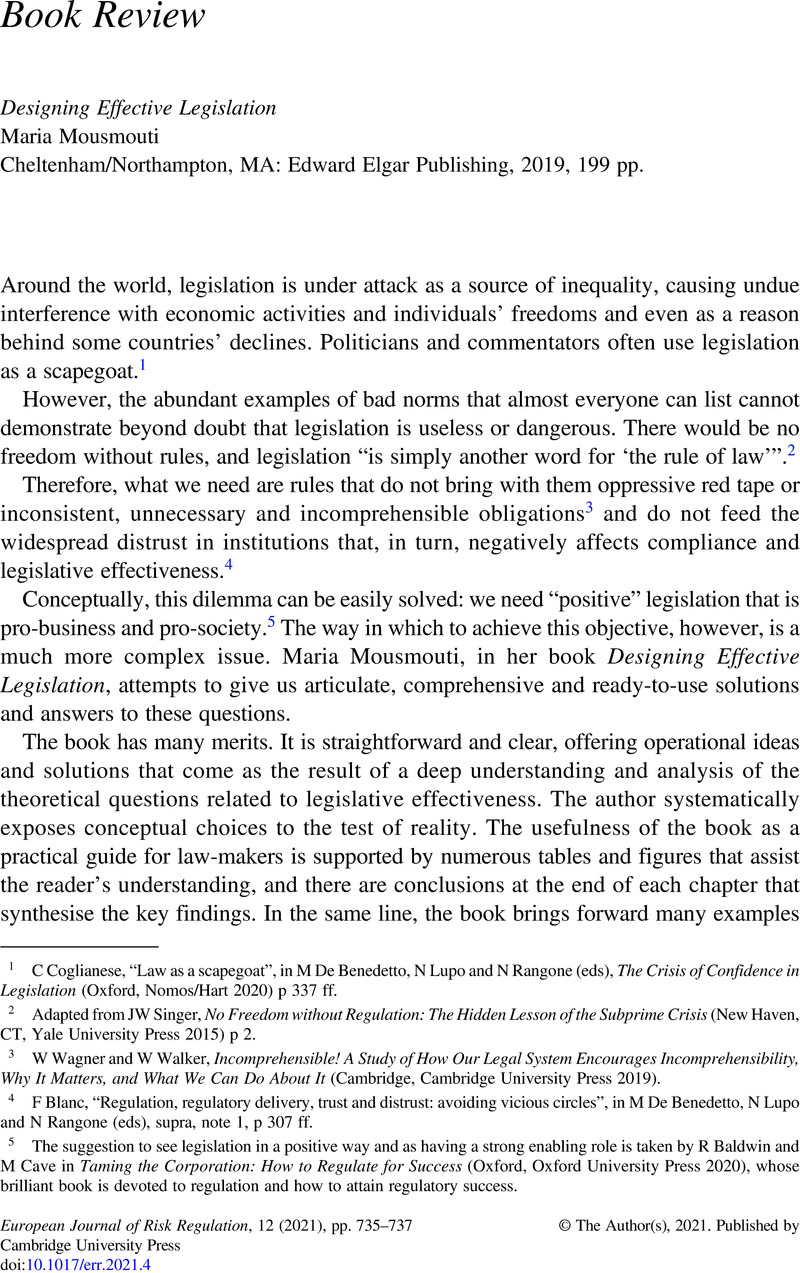No CrossRef data available.
Article contents
Designing Effective Legislation, Maria Mousmouti, Cheltenham/Northampton, MA: Edward Elgar Publishing, 2019, 199 pp.
Published online by Cambridge University Press: 25 March 2021
Abstract

- Type
- Book Review
- Information
- European Journal of Risk Regulation , Volume 12 , Issue 3: Special Issue on Biotechnology in International Economic Law and Human Rights , September 2021 , pp. 735 - 737
- Copyright
- © The Author(s), 2021. Published by Cambridge University Press
References
1 Coglianese, C, “Law as a scapegoat”, in De Benedetto, M, Lupo, N and Rangone, N (eds), The Crisis of Confidence in Legislation (Oxford, Nomos/Hart 2020) p 337 ff.Google Scholar
2 Adapted from JW Singer, No Freedom without Regulation: The Hidden Lesson of the Subprime Crisis (New Haven, CT, Yale University Press 2015) p 2.
3 W Wagner and W Walker, Incomprehensible! A Study of How Our Legal System Encourages Incomprehensibility, Why It Matters, and What We Can Do About It (Cambridge, Cambridge University Press 2019).
4 F Blanc, “Regulation, regulatory delivery, trust and distrust: avoiding vicious circles”, in M De Benedetto, N Lupo and N Rangone (eds), supra, note 1, p 307 ff.
5 The suggestion to see legislation in a positive way and as having a strong enabling role is taken by R Baldwin and M Cave in Taming the Corporation: How to Regulate for Success (Oxford, Oxford University Press 2020), whose brilliant book is devoted to regulation and how to attain regulatory success.
6 H Xanthaki, Drafting Legislation: Art and Technology of Rules for Regulation (Oxford, Hart Publishing 2014) p 76.
7 JJ Rachlinski and CR Farina, “Cognitive Psychology and Optimal Government Design” (2002) 87(2) Cornell Law Review 549.
8 MA Livermore, V Eidelman and B Grom, “Computational assisted regulatory participation” (2018) 93(3) Notre Dame Law Review 977 ff.
9 W Voermans and E Verharden, “Leda: a semi-intelligent legislative drafting support system” (1993) Jurix 81 ff.; M Zalnieriute, LB Crawford, J Boughey, LB Moses and S Logan, “From rule of law to statute drafting. legal issues for algorithms in government decision-making”, in W Barfield (ed.), Cambridge Handbook on the Law of Algorithms (Cambridge, Cambridge University Press 2020) p 256 ff. Algorithms might also be used in order to produce a huge number of amendments so as to block legislative activity (as experienced by the Italian Senate in 2015; see <https://www.repubblica.it/politica/2015/09/23/news/cosi_si_fabbricano_82_milioni_di_emendamenti_la_democrazia_ostaggio_di_un_algoritmo-123525218/>).
10 A Sanchez-Graells, “Procurement in the time of COVID” (2020) 71(1) Northern Ireland Legal Quarterly 81 ff.
11 N Rangone, “Italy’s complex legislative framework impairs its COVID-19 response”, The Regulatory Review, University of Pennsylvania, 8 June 2020 <https://www.theregreview.org/2020/06/08/rangone-italy-complex-legislative-framework-impairs-covid-19-response/>.
12 A-L Sibony, “The UK COVID-19 response: a behavioural irony?” (2020) 11(2) European Journal of Risk Regulation 350 ff.


